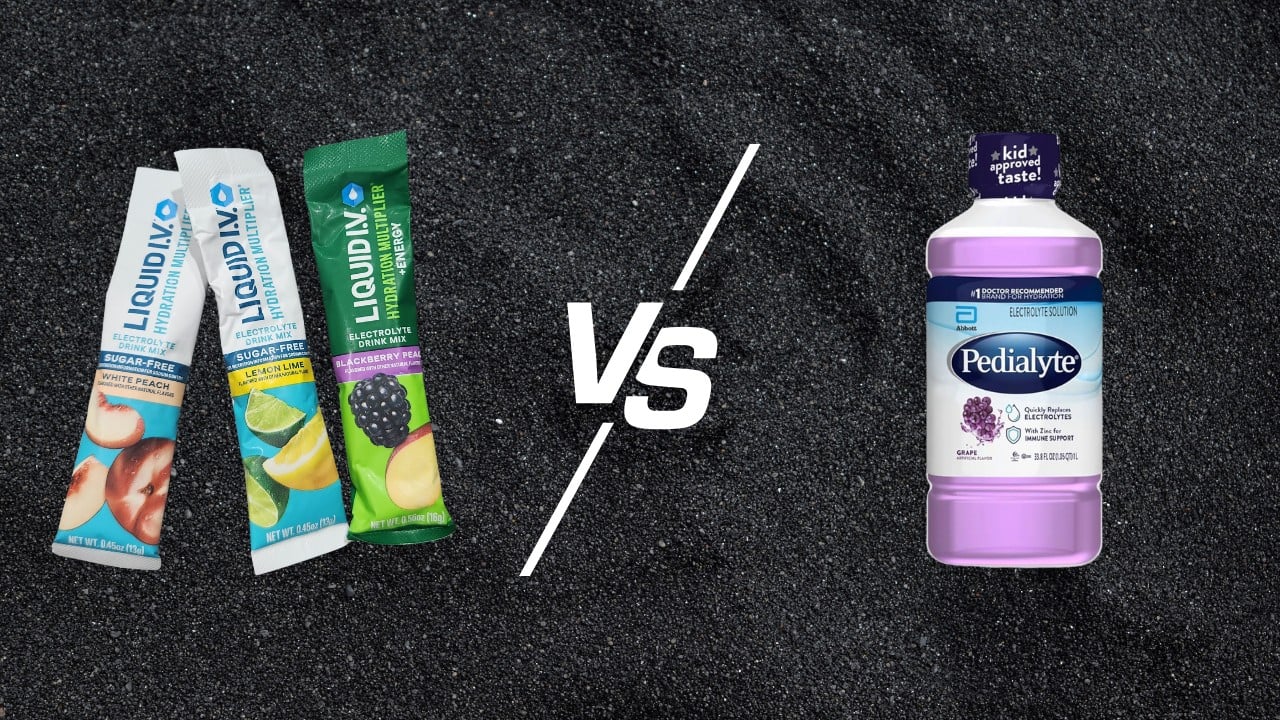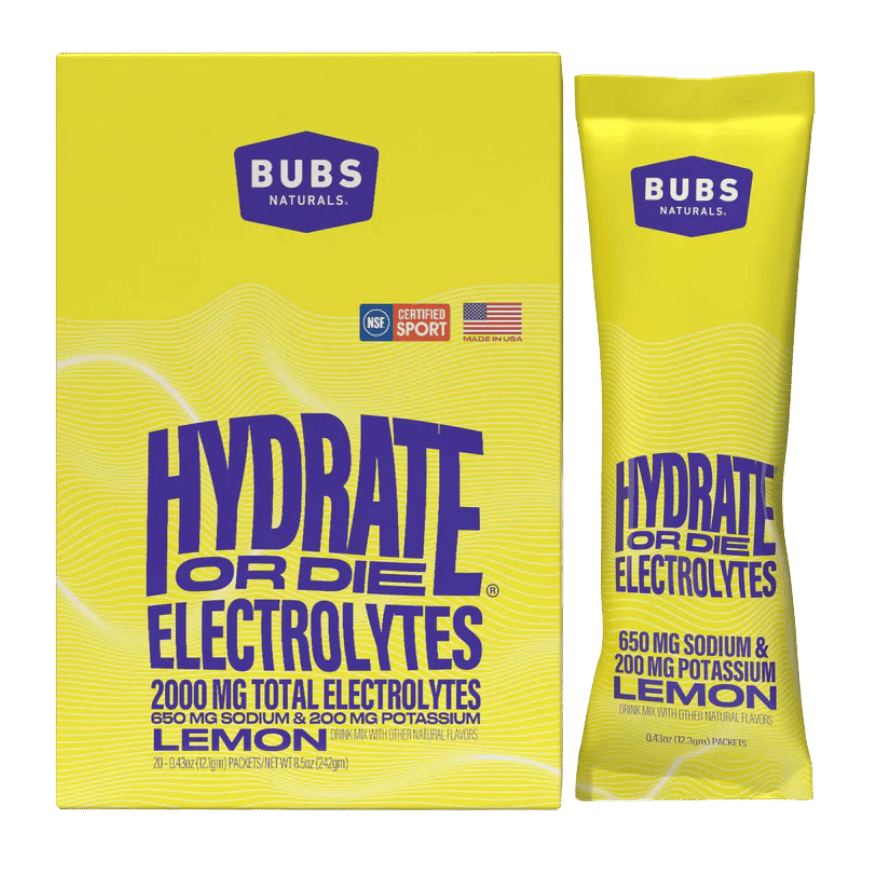I spent six months and over $200 testing Liquid IV and Pedialyte across every dehydration scenario imaginable—from marathon training in Texas heat to surviving norovirus with two kids.
What started as finding the “best” hydration powder ended with discovering why both fall short of what our bodies actually need.
Quick Verdict
Skip the false choice between Liquid IV’s sugar bomb (11g per serving) and Pedialyte’s medicine-cabinet misery.
Bubs Natural Hydrate or Die delivers 650mg sodium with less sugar and a taste that won’t trigger your gag reflex.
At $1.30 per serving, it costs less than both while solving the fundamental problem: adults need serious electrolytes without liquid candy or punishment drinking.
After testing all three during everything from hangovers to hundred-mile bike rides, Hydrate or Die is the only one that stays in my gym bag, office, and medicine cabinet.
Because whether you’re recovering from deadlifts or food poisoning, your hydration needs don’t change, just the severity.
What Is Liquid IV
Liquid IV emerged from a Venice Beach garage in 2012 when founder Brandin Cohen discovered Cellular Transport Technology while researching faster hydration methods for developing countries.
The company, now owned by Unilever since 2020, produces powdered drink mixes that claim to deliver hydration 2-3x faster than water alone through their proprietary CTT system, essentially a specific ratio of sodium, glucose, and potassium designed to enhance water absorption in the small intestine.
The flagship Hydration Multiplier contains 500mg sodium, 370mg potassium, and 11g sugar per stick, which you mix into 16 ounces of water. Each serving delivers 45 calories and comes in flavors ranging from Lemon Lime to Piña Colada. T
he product line has expanded to include Energy Multiplier (with matcha and guayusa), Sleep Multiplier (with melatonin and L-theanine), and Immune Support versions.
A single stick typically costs $1.50-2.00 when bought in bulk, with the powder packaged in individual portable packets designed for on-the-go mixing.
The company operates on a one-for-one donation model, having provided over 50 million servings to underserved communities globally through partnerships with Direct Relief and PATH.
Their products are manufactured in FDA-registered facilities and certified non-GMO, though they’re classified as dietary supplements rather than medical-grade rehydration solutions. You can read my Liquid IV review for my experience.
What Is Pedialyte
Abbott Laboratories created Pedialyte in 1966 specifically for pediatric dehydration in clinical settings, formulating it to meet World Health Organization standards for oral rehydration therapy.
The medical-grade solution contains a precise electrolyte balance: 1030mg sodium, 780mg potassium, and 370mg chloride per liter, with minimal sugar (9g per 12 oz serving) to optimize absorption without causing osmotic diarrhea, a risk with higher sugar concentrations.
Originally available only in hospitals and by prescription, Pedialyte hit retail shelves in the 1980s as a ready-to-drink liquid in plastic bottles.
The classic unflavored version tastes notably salty-sweet, which led Abbott to develop flavors like Cherry Punch and Grape, though the medicinal undertone remains.
The product line now includes powder packets ($5-7 per 6-pack), freezer pops for children, and Pedialyte Sport with higher sodium content for athletes.
Each 12-ounce serving contains 35 calories and costs roughly $1.50-2.00 for the ready-to-drink version. The powder packets, introduced in 2017 to compete with emerging hydration brands, mix into 8 ounces of water.
Abbott maintains pharmaceutical-grade manufacturing standards, with Pedialyte regulated as a medical food by the FDA, a classification requiring stricter quality controls than dietary supplements.
The brand pivoted its marketing around 2015 when data showed 60% of Pedialyte purchases were for adult use, particularly hangover recovery.
This shift spawned the “See The Lyte” campaign targeting adults, though the formulation remains identical to the original pediatric version. Hospitals still stock Pedialyte as their primary oral rehydration solution for mild to moderate dehydration cases.
Liquid IV vs. Pedialyte Main Differences
Sugar Content
The sugar gap between these two hits you immediately when you check the labels. Liquid IV packs 11 grams of cane sugar into each stick (unless you buy the sugar free version), about as much as you’d find in three Oreo cookies.
They argue this amount is necessary for their Cellular Transport Technology to function, claiming the glucose-sodium ratio triggers maximum water absorption in your small intestine.
Pedialyte plays it conservative with 9 grams per 12-ounce serving, but here’s the kicker, that’s for nearly double the liquid volume.
Ounce for ounce, Pedialyte contains roughly half the sugar concentration. Abbott’s scientists formulated it this way to prevent osmotic diarrhea, a real concern when you’re already dehydrated.
The lower sugar content explains why emergency rooms stock Pedialyte instead of sports drinks for severe dehydration cases.
One pediatric nurse told me they specifically choose Pedialyte because higher sugar concentrations can actually pull water into the intestines, worsening dehydration in sensitive patients.
Sodium & Potassium Content
Pedialyte dominates the sodium game with 1030mg per liter versus Liquid IV’s 500mg per 16-ounce serving. Before you assume more is better, consider this: I learned the hard way that chugging high-sodium Pedialyte on an empty stomach at 6 AM feels like drinking ocean water.
That intense salt hit serves a medical purpose, it’s calibrated to replace what you lose during severe fluid loss from vomiting or diarrhea.
The potassium story flips the script. Liquid IV delivers 370mg while Pedialyte provides 780mg per liter (about 280mg per 12-ounce serving).
This matters more than you’d think. After tracking my intake for a month, I noticed Liquid IV barely dented my daily potassium needs, while Pedialyte made a meaningful contribution.
Potassium helps your muscles fire properly, crucial when you’re recovering from exercise or illness. One marathon runner in my building swears the higher potassium in Pedialyte prevents her post-race leg cramps better than anything else she’s tried.
Taste
Liquid IV tastes like what would happen if Vitamin Water and Gatorade had a baby, sweet, fruity, and immediately palatable.
The Passion Fruit flavor literally made my kids ask for “the special water” after soccer practice. Even the Lemon Lime version masks any salt taste completely under waves of citrus sweetness. You could serve this at a party and people would just think it’s a fancy flavored water.
Pedialyte tastes like medicine because it essentially is medicine. The unflavored version triggered visceral flashbacks to childhood stomach bugs the first time I tried it.
Even the “improved” flavors like Strawberry and Orange carry an unmistakable pharmaceutical undertone, that specific combination of salt, artificial sweetener, and something vaguely metallic.
Convenience
Liquid IV wins the portability battle without question. Each stick weighs less than a car key and slips into any pocket, wallet, or that weird mesh part of your gym bag.
I’ve mixed them into airport water bottles, camping canteens, and once, desperately, into a half-empty Dasani during a conference. The powder dissolves in 30 seconds of shaking—no chunks, no grit, no standing there stirring forever like an idiot.
Pedialyte’s traditional bottles require planning. You’re hauling around 33.8 ounces of liquid that needs refrigeration after opening. Try explaining to TSA why you need a full liter of mysteriously colored liquid in your carry-on.
The powder packets level the playing field somewhat, but they still mix into just 8 ounces versus Liquid IV’s 16, meaning you need twice as many packets for the same volume.
Plus, Pedialyte powder takes genuine effort to dissolve, I’ve spent full minutes attacking clumps with a fork like I’m making scrambled eggs.
Best For
Liquid IV shines for active adults who want hydration that doesn’t feel like punishment. It’s ideal for pre-workout energy, post-yoga recovery, or combating that 3 PM office dehydration headache.
Festival-goers, travelers, and anyone who struggles to drink enough water gravitate toward it because it makes hydration feel like a treat rather than a chore. The sugar content actually helps if you’re replacing glycogen after intense exercise.
Pedialyte belongs in your medicine cabinet for genuine medical-grade rehydration. When norovirus decimates your household, when food poisoning strikes during vacation, when your toddler can’t keep anything down, that’s Pedialyte territory.
Athletes doing extreme endurance events often prefer it because the higher sodium replaces heavy sweat losses without the sugar crash. Hospitals trust it for a reason: it’s formulated to handle serious dehydration, not just morning-after regret.
Main Drawbacks
Liquid IV’s sugar content becomes problematic if you’re drinking multiple servings daily. At 11 grams per stick, three packets equal a Coca-Cola’s worth of sugar.
The cost also stings. Roughly $24 for 16 servings means you’re paying $1.50 every time you want fancy water. The sweetness can trigger nausea if you’re genuinely ill, and the lower sodium means it’s less effective for severe dehydration. Some users report the artificial colors stain clear water bottles permanently.
Pedialyte’s taste remains its Achilles heel. Even fans admit they’re choking it down for results, not enjoyment. The ready-to-drink bottles create absurd amounts of plastic waste, and once opened, you have 48 hours before that $6 bottle becomes expensive drain cleaner.
The lower sugar might seem like a benefit, but it means less immediate energy replenishment after intense exercise. The medical association makes some people feel dramatic using it for basic hangovers, like taking an ambulance for a paper cut.
My Experience With Liquid IV & Pedialyte
Liquid IV
I discovered Liquid IV at 5 AM in a Phoenix airport, desperately searching for hangover salvation before a work presentation. The Walgreens attendant handed me a variety pack with a knowing nod, “Passion Fruit works fastest,” she said.
Twenty minutes later, sitting at gate B4 with an overpriced bottle of Smartwater turned electric yellow, I felt marginally better but also weirdly jittery. Like someone had replaced my hangover with a sugar rush that made my hands shake during my presentation opener.
Over six months, Liquid IV became my expensive Band-Aid for poor hydration habits. Morning runs in Austin’s August humidity? Lemon Lime beforehand helped, but by mile three I’d crash harder than before, my body burning through those 11 grams of sugar like kindling.
My running buddy Marcus started calling it “yellow cope juice” after watching me bonk during hill workouts despite drinking it religiously. The worst part? I kept buying it, convinced the problem was my fitness rather than mainlining sugar water before cardio.
The Watermelon flavor triggered actual acid reflux during a wine-tasting weekend, turns out mixing 11 grams of sugar with fourteen Malbec samples creates a special kind of digestive hell.
My wife tried it once for her Orangetheory class and spent the entire workout feeling like she’d eaten candy for breakfast. The artificial colors turned her water bottle permanently pink, a $40 casualty she still reminds me about.
But here’s where Liquid IV completely failed: actual illness. When food poisoning from sketchy airport sushi left me hugging the toilet at 3 AM, that sweet Strawberry packet triggered instant revolt.
The sugar that supposedly aids absorption felt like pouring corn syrup into my already-angry stomach.
Pedialyte
My Pedialyte nightmare began during the great outbreak of 2020, when my entire household fell like dominoes. My neighbor, a pediatric ICU nurse, dropped off four bottles of unflavored Pedialyte with instructions: “Small sips every 15 minutes. Yes, it tastes terrible. It works.”
That first sip tasted like someone had dissolved road salt in expired Sprite. It took forty minutes of aggressive negotiations with my gag reflex to finish eight ounces. Yes, the room eventually stopped spinning, but at what cost?
My wife found me lying on the bathroom floor, empty bottle beside me, muttering “never again” like a war veteran. The Orange flavor I tried next somehow tasted worse, like Tang mixed with tears and regret.
Marathon training with Pedialyte felt like voluntary torture. After my 20-mile long run, I forced down 32 ounces while sitting in my car, each gulp a conscious override of my body’s rejection.
Other runners stared as I visibly shuddered between sips. Sure, I felt less destroyed the next morning, but I also spent $8 on what amounted to medically-approved salt water. The psychological damage of associating recovery with that taste lingered through my entire training cycle.
I bought Pedialyte freezer pops thinking they’d improve the experience. They didn’t. They just made the misery colder and last longer. My kids tried one and accused me of giving them “frozen medicine” as punishment.
Even my dog, who eats literal garbage, sniffed a melted pop and walked away. After particularly brutal Texas summer yard work, I’d force one down while questioning every life choice that led to this moment, a grown man eating medical popsicles in his kitchen, trying not to breathe through his nose.
The breaking point came when I realized I’d rather stay dehydrated than drink another bottle of Grape Pedialyte. That’s not a hydration solution, that’s Stockholm syndrome in liquid form.
Should You Take Liquid IV or Pedialyte?
After spending $200+ testing both products across every conceivable scenario, hangovers, workouts, illness, travel, and one regrettable century bike ride, I’ve reached an uncomfortable truth: they’re both solving yesterday’s problems with outdated solutions.
Here’s what six months of hydration experiments taught me: Liquid IV makes you choose between effective hydration and a sugar crash, while Pedialyte makes you choose between proper electrolytes and wanting to die every time you drink it.
One tastes like candy but lacks serious sodium, the other packs medical-grade minerals but tastes like punishment. After my third bout of decision paralysis in the CVS supplement aisle at 6 AM, sweating through a hangover, I started hunting for something better.
Enter Bubs Natural Hydrate or Die. A name so aggressively confident that I initially dismissed it as bro-science nonsense. Then I saw the formula: 650mg sodium, legitimate potassium levels, and less sugar.
It tastes like… actual lemon lime water. Not artificial, not medicinal, just clean citrus with a slight salt edge that reminded me I was drinking something functional.
At $1.30 per serving, Hydrate or Die costs less than both Liquid IV and Pedialyte while delivering what neither can: medical-grade hydration that doesn’t require choosing between effectiveness and drinkability. I’ve replaced both my Liquid IV stash and my emergency Pedialyte with it.




